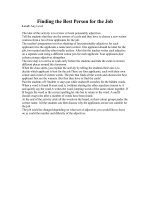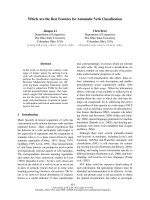the king in jeopardy the best tecnkques for attack and defense
Bạn đang xem bản rút gọn của tài liệu. Xem và tải ngay bản đầy đủ của tài liệu tại đây (2.86 MB, 292 trang )
The King in Jeopardy
by
Three-time U.S. Champion
GM Lev Alburt
and
GM Sam Palatnik
EBook edition published by Chesswise.com
Originally published by Chess Information and Research Center
P.O. Box 534
Gracie Station
New York, NY 10028
Distribution to the book trade by:
W.W. Norton, 500 Fifth Avenue, New York, NY
Second, revised edition editing: OutExcel! Corp., Al Lawrence, President
Editor: Mark Ishee
Editorial Advisers: Eric C. Johnson, Bleys Rose
Special Editorial Consultant: Roman Pelts
Translator: Olga Palatnik
Proofreaders: Andrew Mongin, Kent Meadows, Peter Kurzdorfer
Cover: Mark Kostabi’s painting, “The King in Jeopardy”
Art Consultant: Lev Maximov
Drawings: Patricia Melvin
© Copyright 1996, 1999. Lev Alburt and Sam Palatnik. All rights reserved.
eISBN 1-59062-140-9
This book is also available in print as ISBN 1-889323-13-6.
Contents
Foreword
Introduction
Part I:
The King in the Center
Lesson One:
Attacking the King in the Center
Principles for attacking the uncastled king
Sacrifice to open lines (Morphy — Amateur)
Punishment for losing time in the opening (Anderssen — Kieseritsky)
Exchanging to prevent castling (Steinitz — von Bardeleben)
Lack of harmony (Tchigorin — Salwe)
A practical decision (Gruenfeld — Spielmann)
Opening or middlegame? (Tolush — Botvinnik)
Unexpected sacrifice (Holmov — Keres)
Nowhere to hide (Fischer — Rubinetti)
Probing for weaknesses (Fischer — Dely)
Pursuit (Tatai — Karpov)
Suicide (Anand — Kasparov)
Lesson Two:
When the King is Safe in the Center
Is castling necessary? (Kmoch — Alekhine)
Harmonious regrouping (Kotov — Keres)
Correctly evaluating the king in the center
Exercises for Part I
Part II:
Attacks with Same-Side Castling
Lesson Three:
Piece Attacks with Same-Side Castling
The stronger side must attack! (Steinitz — MacDonnell)
Piece attacks against weak pawn structure
Target on g6 (Spielmann — Honlinger)
Target on h6 (Capablanca — Levenfish)
Invading weak squares (Alatortsev — Boleslavsky)
(Smyslov — Stahlberg)
Lack of harmony (Kasparov — Marjanovic)
(Kasparov — Pribyl)
Weak diagonal (Alekhine — Alexander)
Unprepared attack (Capablanca — Becker)
Piece attacks against strong pawn structure
Combination to increase activity (Euwe — Keres)
Exchanging to increase activity (Tal — Najdorf)
Sacrifice to divert defenders (Alekhine — Sterk)
The importance of greater activity in piece attacks
Open and closed positions
Counterattack
Successful counterattack against overextended attacker (Geller — Euwe)
Lesson Four:
Pawn Attacks with Same-Side Castling
Attacking with one pawn
Creating a weakness (Reti — Alekhine)
Opening a file (Lasker — Capablanca)
Activating every piece (Botvinnik — Vidmar)
Advancing prematurely (Brinkman — Bogolyubov)
Wing thrust vs. central counterplay (Unzicker — Reshevsky)
Attacking with multiple pawns
Space advantage (Gereban — Smyslov)
Slow buildup (Reti — Carls)
Opening files (Alekhine — Astalosh)
Queenside counterplay (Bisguier — Petrosian)
Transition to the endgame (Riumin — Kan)
Exercises for Part II
Part III:
Attacks with Opposite-Side Castling
Lesson Five:
Attacks with Opposite-Side Castling
Superior mobility and coordination (Bird — Morphy)
No counterplay (Capablanca — Janowsky)
Open lines at any cost (Tchigorin — Pillsbury)
(Rubinstein — Teichmann)
Attacking the fianchetto (Spassky — Evans)
(Boleslavsky — Geller)
Invasion on the a-file (Gereban — Geller)
Extending a diagonal (Razuvayev — Kapengut)
Kingside majority (Alekhine — Marshall)
Exercises for Part III
Conclusion
Index of Games
Foreword
This revised, second edition of The King in Jeopardy has been completely
re-edited and corrected. Although the pagination of the previous edition
was retained, each and every page was re-typeset and re-plated for this
new printing.
Ironically, testimony to the timelessness of this book’s material is given by
an updated example, exercise 9 on page 191, Kramnik—Kasparov,
Novgorod, 1997. Kramnik’s brilliant move that starts a winning
combination against the world champion owes its conception to the more
than a century and a half of attacking theory and practice reviewed in this
book. GM Kramnik himself acknowledged his debt to the never-out-ofdate cornerstones of attacking chess when he remarked after the game,
“Back in my childhood I was taught that such a (winning) motif is called
overloading.”
The King in Jeopardy is the fourth volume in the six-volume
Comprehensive Chess Course series. This book assumes that the reader is
familiar with the rules of chess. While it can also stand alone, this book
builds on the basic chess concepts and tactical ideas outlined in the
previous volumes of the Course.
The Comprehensive Chess Course originated in the former Soviet Union
as a means of providing students with the most effective chess training.
Thousands of masters and grandmasters were raised on this course of
study. The Comprehensive Chess Course is based on the method of
repeatedly presenting certain problems to students. The problems become
progressively more difficult, combining new ideas with familiar ones,
thereby broadening the student’s knowledge and simultaneously
reinforcing previously mastered material.
Like all the other volumes in the Course, The King in Jeopardy is
designed to be an ideal self-study guide. All the ideas are thoroughly
explained.
We wish to take this opportunity to acknowledge our heavy debt to FM
Roman Pelts, our special editorial consultant. In addition our editorial
advisers—Eric Johnson, Larry Parr, and Bleys Rose—provided a lot of
useful criticism and ideas for improvements, for which we are grateful.
Important help was also received from Mark Ishee, while Lev Alburt’s
students Dr. Martin Katahn and Greg Neu provided useful advice on how
to make this book user-friendly for novices and non-masters.
In preparing and marketing this second, revised edition of The King in
Jeopardy, we’ve been fortunate to be assisted by Al Lawrence, formerly
Executive Director of the US Chess Federation, and now President of
OutExcel! Corporation. Al, who promoted USCF’s sales and membership
to record highs, stays active in the world of chess. He’s co-authored three
books, Chess for Children, Winning Chess: Piece by Piece, and (with GM
Lev Alburt) Playing Computer Chess: Sharpening Your Game, all from
Sterling Press, available from the US Chess Federation and on the internet
at www.chesscafe.com. This website offers book reviews, photos, chess
want ads, and general and technical articles by leading chess thinkers from
around the world.
— GMs Lev Alburt and Sam Palatnik
New York City
October 15, 1998
Introduction
Every chess player, even one who has just taken his first steps in chess,
becomes very inspired when he has a chance to make threats directly
against the opponent’s king. Sometimes even the opportunity simply to
make a move that gives check brings joy to the beginner! This reaction is
easy to understand, since the goal of the game is to checkmate the king.
When threats to the enemy king are created, sharp positions often occur.
Sometimes these positions are full of chances to play beautiful
combinations—one of the major reasons players are attracted to chess.
Problems connected with making an attack on the king necessarily occupy
an important place in the theory of the middlegame. It is important for
players of all strengths to be able to storm the opponent’s king effectively,
and this is the subject of our book.
Because the attack on the king often involves various kinds of typical
combinations and sacrifices, we also recommend that our readers
familiarize themselves with various tactical devices by reading the
previous book in this series, Chess Tactics for the Tournament Player.
Among the many factors that go into evaluating any position, the relative
positions of the kings are among the most important. By analyzing
numerous examples, we will determine the important characteristics of
each major category of positions, and we will also explain typical plans
and methods for attack and defense.
Because chess skill is gained primarily through repetition, we have
included sets of exercises at the end of each major section of the book. We
strongly encourage our readers to work through these exercises with a
chess set, taking notes and reaching a general conclusion about each
position before going on to the solutions page. At first the exercises may
present quite a challenge, but the reader will soon notice an improvement
in spotting the correct line of play, as well as in his or her overall thinking
style. Time spent on the exercises (and the examples in the text) will soon
translate into better understanding during one’s own tournament games,
and into better results.
Our discussion is intended to be of direct practical benefit. Along the way
we will make generalizations and conclusions, all of which are intended to
give the readers the necessary experience and knowledge to allow them to
navigate the choppy waters of tournament play. Our hope is that where our
readers were formerly uncertain or hesitant, they will come to believe in
their ability to attack as well as to defend. We hope that our readers, once
armed with these new skills, will then use their creative potential to
greater effect in the future.
Part I:
The King in the Center
Lesson One
Attacking the King in the Center
In most cases, the chess struggle begins in the center of the board, not on
the flanks. Each player starts by trying to obtain dominance in the center
by occupying one or more of the central squares — d4, d5, e4, e5. These
squares are commonly called “the center” in chess literature. Control of
the center, and of the neighboring squares within the rectangle enclosing
c3, c6, f6 and f3 (known as the expanded or widened center) allows
greater maneuverability and coordination among the pieces, and lays the
foundation for a successful attack on the king.
When we refer to an attack on the king in the center, we do not literally
mean that the king is in the center of the board on d4, d5, e4 or e5, but that
he has remained uncastled and is still on his initial square or on a nearby
square on one of the central files. As we shall see, this placement of the
king may prove to be quite fraught with danger in the middle game, or
even during the transition from opening to the middle game.
The clash of pawns in the center creates tension, and an exchange is likely
to occur. Such an exchange will lead to the opening of one or more files or
diagonals, which in turn allows pieces to achieve greater activity. If the
opponent’s king is still in the center and one’s forces can be aimed in his
direction, the road is now open for an attack. Defense may prove difficult,
because without castling the defender’s rooks are disconnected and cannot
easily be brought to the aid of the king.
If there are open files in the center, these can be a highway for the
attacking pieces. A piece which is in the center of the board enjoys greater
freedom of action and has more options. This is especially true of knights,
which travel more slowly than the bishop, rook, or queen. So when the
enemy king sits on the central files, he is an easier target for an attack.
This is not to say that a king in the center is always bad, or in serious
danger. If there is a solid pawn barrier in front of it, then the king can feel
secure in his fortress. But you don’t encounter such exceptions very often.
In most cases, an uncastled king is a juicy target.
Principles for attacking the uncastled king
The presence of the opposing king in the center does not by itself
guarantee success for the attack. In order to get at the target you have to
marshall your forces and find a way to break through whatever defense the
enemy possesses. Your attack must be prepared, and there are two
characterisics of such preparation. First, you have to have superior
development. Second, you must grab hold of the initiative.
When attacking an uncastled king, you should try to:
1. Prevent the enemy king from fleeing the central area. The king is
usually in much greater danger in the middle of the board.
2. Open as many lines (files and diagonals) as possible leading
toward the enemy king.
3. Involve as many of your pieces in the attack as you can. The more
pieces you use, the easier it is to develop an offensive, and the
more difficult the defensive task becomes.
4. Keep the opposing army disorganized. When the king is in the
center on the back rank, it interferes with the communication
between the rooks, and this makes it more difficult to organize the
defense. It is best to keep your opponent’s lines of communication
broken.
Keep these four principles in mind as we look at some examples of
successful attacks against the king in the center.
Sacrifice to open lines
Diagram 1
Morphy—Amateur
New Orleans 1858, blindfold simul
Position after Black’s 7th move
By sacrificing a piece White keeps the opponent’s king in the center and
organizes a direct attack.
8. Nxf7!
9. Qf3+
Kxf7
Diagram 2
9. ...
Ke6
Black must play this move to keep the extra piece, or else White will have
the advantage without any risk. Other moves don’t give Black any hope
for equality:
A) 9. ... Ke8 10. Bxd5 Rf8 (10. ... Ne5 11. Qh5+ Ng6 12. Re1, or 10. ...
Qd6 11. Qf7+ Kd8 12. Qxg7 Bf6 13. Bg5) 11. Bxc6+ bxc6 12. Qxc6+
Bd7 13. Qc4 and Black doesn’t have compensation for a pawn.
B) 9. ... Bf6 10. Bxd5+ Be6 11. Bxe6+. (Winning a pawn in this position
makes no sense because after 11. Bxc6 bxc6 12. Qxc6, Black has better
development and two strong bishops.) 11. ... Kxe6 and now, after the
simple 12. Bf4, Black’s king is uncomfortably placed in the center and
cannot find refuge; for example, 12. ... Kf7 13. Qb3+, or 12. ... Kd7 13.
Qh3+.
10. Nc3!
This sacrifice helps White develop his attack in a swift and forceful
manner. In this game the opponent’s king ended up literally in the center
of the board!
Diagram 3
10. ...
dxc3
11. Re1+
Ne5
Black’s reply is forced.
12. Bf4
Bf6
If Black tries 12. ... c6, White plays 13. Rxe5+ Kd7 (if 13. ... Kf7 instead,
there follows 14. Bxd5+ cxd5 15. Rxe7+ winning the queen or creating an
irresistible attack) 14. Rxd5+ cxd5 15. Qxd5+ Ke8 16. Qf7+ Kd7 17. Bb5
mate.
13. Bxe5
Bxe5
Diagram 4
14. Rxe5+!
Kxe5
15. Re1+
Kd4
16. Bxd5
Diagram 5
Black has an extra rook, but his “centralized” king appears to be in a
mating net. Right now White’s main threat is 17. Qxc3+ Kxd5 18. Re5+
Kd6 19. Qc5+ Kd7 20. Qd5 mate. In addition, White is also threatening
17. Qe4+ Kc5 18. b4+ Kb5 ( If 18. ... Kb6, then 19. Qd4+ Ka6 20. Qc4+
b5 21. Qc6 mate, and 18. ... Kd6 will be followed by 19. Qe5+ Kd7 20.
Qe6 mate) 19. a4+ Kxa4 20. Ra1+ with mate to follow. The same idea can
be seen after 17. Qd3+ Kc5 18. b4+ etc.
Of course now Black cannot recapture with 16. ... Qxd5? because of 17.
Qxc3 mate. Let’s look at some other possible variations:
1. 16. ... c6 17. Qe3+ Kxd5 18. Qe5+ Kc4 19. Re4+ and mate next
move.
2. 16. ... Qf6 17. Rd1+ Kc5 (or 17. ... Ke5 18. Qe4+ Kd6 19. Bc4+ )
18. Qe3+ Kb5 19. a4+ Kxa4 20. Qe4+, etc.
3. 16. ... Qg5 17. Qd3+ Kc5 18. b4+ Kxb4 19. Qd4+.
4. 16. ... Qd6 17. b4 Qxb4 18. Re4+ Kc5 19. Qe3+.
16. ...
Re8
17. Qd3+
Kc5
18. b4+!
Kxb4
19. Qd4+
Diagram 6
And White will announce checkmate in a few moves. In this game
Morphy showed excellent technique in pursuing the attack on the king in
the center. White’s play is even more impressive when we consider that
the game was played more than a hundred years ago in what is known as a
simultaneous blindfold exhibition!
Punishment for losing time in the opening
Diagram 7
Anderssen — Kieseritsky
London, 1851
1. e4
e5
2. f4
exf4
3. Bc4
Qh4+
4. Kf1
b5
The purpose of this counter-sacrifice is to deflect White’s bishop from the
f7-square.
5. Bxb5
Nf6
6. Nf3
Qh6
Diagram 8
It seems more natural to play 6. ... Qh5, but Kieseritsky wants to leave the
h5-square vacant for the knight. The move 6. ... Qh6 is characteristic of
games from the last century, and is a good illustration of the thinking of
that time. By this we mean the tendency to play for tactics alone, without
sufficient attention to control of the center and the coordination of the
pieces.
7. d3
Nh5
Diagram 9
Black builds his game on small tactical threats which are easy to stop.
Better was 9. ... c6.
8. Nh4
The threat was 8. ... Ng3+. On 8. Kg1? Black would play 8. ... Qb6+.
8. ...
Qg5
Also deserving attention is 8. ... Bb7, so that on 9. g4 Nf6 10. Nf5 Black
has the reply 10. ... Qh3+.
9. Nf5
c6
10. g4
Nf6
Diagram 10
11. Rg1!
When he offered his bishop to Kieseritsky, Anderssen could not have
calculated all the variations to the end. But the awkward position of
Black’s queen, plus White’s advantage in development, make this a
promising piece sacrifice. Notice that in order to accept the material,
Black must also weaken his d5-square.
11. ...
cxb5
12. h4
Qg6
13. h5
Qg5
14. Qf3
Diagram 11
Now the threat is 15. Bxf4, trapping Black’s queen. Black is forced to lose
more tempi in order to provide a retreat.
14. ...
Ng8
15. Bxf4
Qf6
Diagram 12
The sad outcome of the opening is a gaping hole on d5, and a huge
advantage for White in the mobilization of his forces. We can see all the
preconditions for a decisive attack on the king.
16. Nc3
Bc5
17. Nd5!
Diagram 13
Of course there is no happiness for Black in the simple 17. d4. However,
Anderssen sensed that the time was right for more energetic action.
17. ...
Qxb2
Now both of White’s rooks are under attack.









